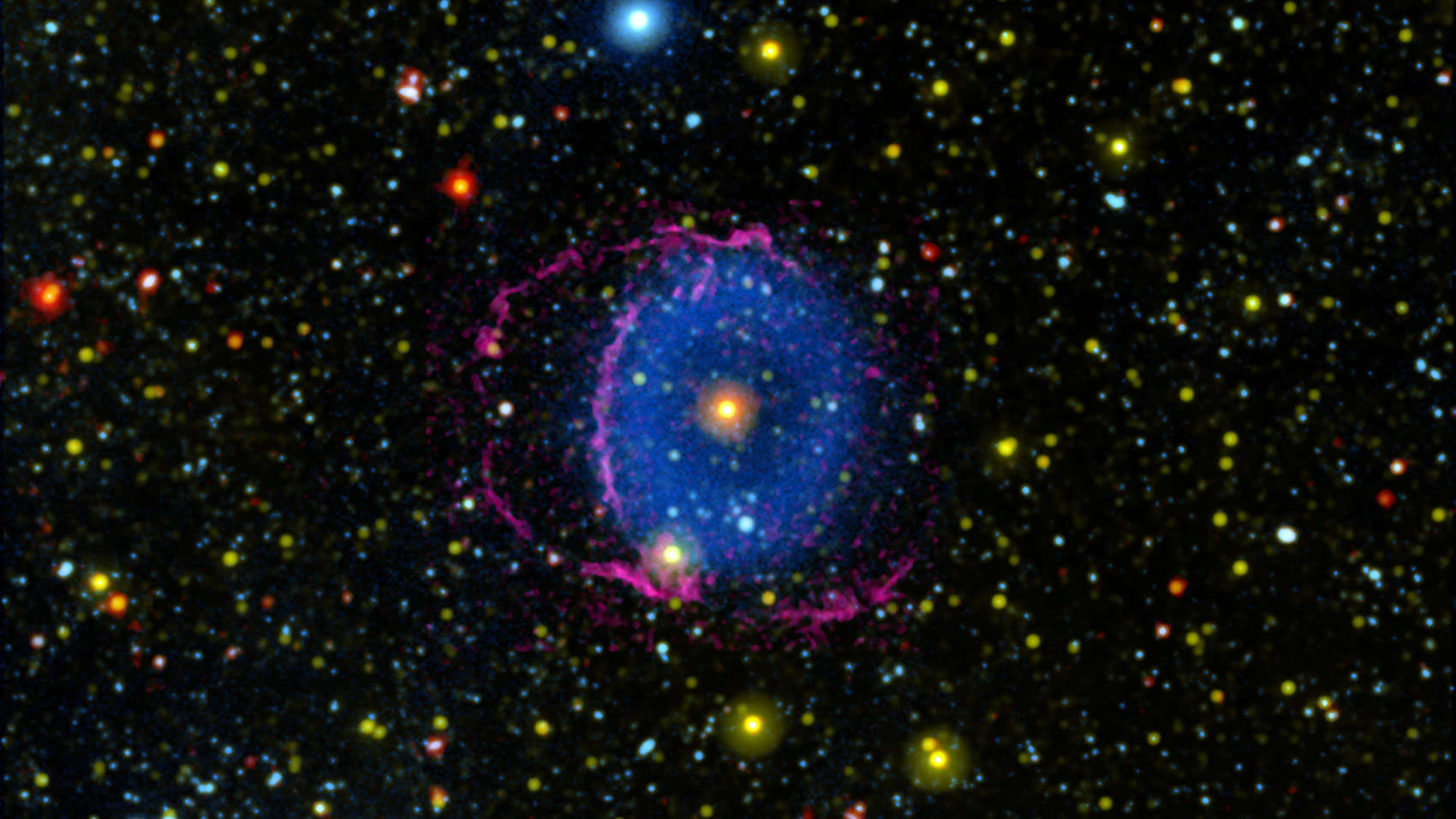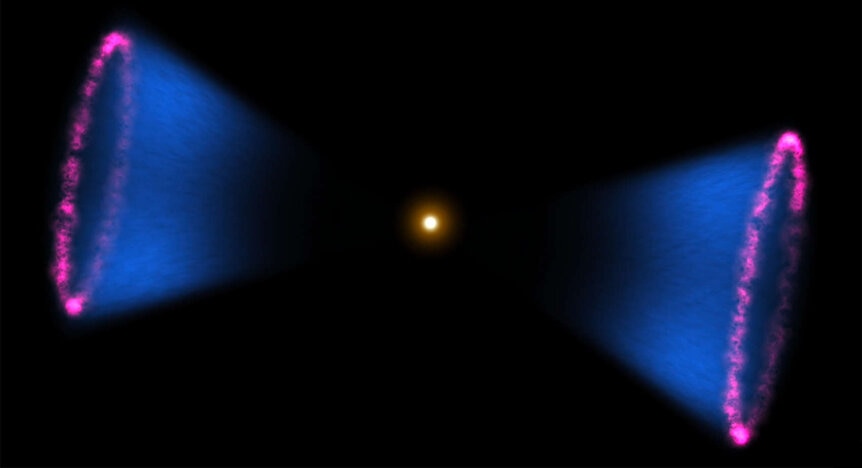Create a free profile to get unlimited access to exclusive videos, sweepstakes, and more!
What created this eerie blue eye in space? Stellar cannibalism.

A mysterious blue ring, like a gigantic eye in space, has been staring down astronomers for years, as if daring them to understand it.
Now it looks like we do. It's not an eye, it's a millennium-long belch: Gas blown out from a star system, where one star ate another and got the equivalent of stellar indigestion.
The star is called TYC 2597-735-1, and it's about 6,300 light years away. In most databases and sky surveys it just looks like, well, a star. But when it was observed by the Galaxy Evolution Explorer (or GALEX) space-based observatory, it saw the star surrounded by a diffuse blue ring a dozen or so light years across, molecular hydrogen (or H2) gas glowing in the ultraviolet.
Nothing like that had ever been seen before! The star itself doesn't have the energy needed to make the ring glow, and it's not clear what could have formed it, either.
However, new observations show that there are thin, sharp loops of material on either side of the ring, warmer and denser hydrogen gas glowing faintly in visible light. These loops are what finally gave the game away: The ring isn't a ring at all. Instead, the star has created a huge structure shaped like thick cone-shaped shells, like two megaphones attached at their narrow ends. The loops are the open ends of the cones, and we're looking very nearly but not exactly down the axis of the two cones, so one is opening up toward us and the other on the other side of the star, away from us. The gas is brighter where we see these two cones overlap.
This animation should help:
Now I know, there's a funny illusion that you may experience watching that where, after the structure rotates once it looks like the cones are suddenly moving in opposite directions. Our brains have a hard time interpreting symmetric structures like this and can be fooled that way*. This second animation, where the conical shells are filled in, might help:
What could have created such an immense structure?
In the new paper, the astronomers make a convincing argument that it's a star that was once like the Sun, except older, and it used to have a very low mass companion star, probably a red dwarf with about 1/10th the Sun's mass. I say “used to”… because the bigger star ate the red dwarf!
As stars age, they tend to swell up, eventually becoming a red giant. In this case, the red dwarf companion (called the secondary) orbited the primary star pretty close in. As the primary started to expand, its surface got so close to the red dwarf that material started to be pulled off the primary and onto the secondary. The flow was so strong that the secondary couldn't hold onto it all, and that extra gas formed a wide disk around both stars (called a circumbinary disk).
This process steals rotational energy from the pair, and so the secondary starts to spiral into the primary. Eventually they merged, the red dwarf plunging into its expanding partner. That's a hugely energetic event — two stars colliding! — and it caused the primary star to blast out a tremendous expulsion of gas and dust.
We've seen this sort of thing before, for example in the incredible V 838 Monocerotis, where an expanding star ate its binary companion and underwent a tremendous outburst, and as the light expanded away it lit up a cloud around it, making it look like the cloud was expanding (in reality, it's the light moving through the cloud making it visible).
It's not clear if TYC 2597-735-1 blew out a thick dust cloud like V838 Mon. But the star itself had changed. It spins faster due to the collision, and the surface is roiling with activity as material from the disk falls onto it. It blows a wind of gas that is moving, screaming away at a terrifying 400 kilometers per second.
However it can't blow in all directions. That disk blocks the way. So instead the wind diverted, flowing up and down, perpendicular to the disk. The result is the gas forms those two cones moving outward, perpendicular to the orbital plane of the former binary star system.
The bases of the cones are brighter because the gas is plowing into the thin gas between stars (called the interstellar medium), piles up a bit, and where it's denser we see more light from it. A shock wave forms, causing the colder molecular gas inside the cones to glow more feebly. That's the ultraviolet glow that we see as the ring in the original GALEX observations.
This stage post-merger doesn't last long; we're seeing TYC 2597-735-1 probably only about a thousand years after the merger event — given that stars live for billions of years, this event was practically yesterday. We'll probably only see up to a dozen examples of stars like this at any one time in the galaxy, and likely fewer, so we're lucky to spot this one. If there are more they'll probably be farther away (this one is close at 6,300 light years in a galaxy 120,000 light years across) and require bigger ultraviolet telescopes to see.
There are plans for something like that (like the extremely ambitious but totally doable LUVOIR observatory) coming in the next couple of decades. I do hope we can find more examples of this short-lived and rare phenomenon, so we can learn more about how stars like this evolve. Also? It's just beautiful. That's a good reason to look for them, too.
*This is very similar to the wonderful Andrus Dragon illusion, where a paper cutout dragon appears to follow you as move around it. I made a demo video of this a while back that will help:





























